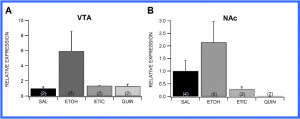Brian Behnke and Scott Steffensen, Psychology
Project Purpose
The purpose of my experiment was To study the effects that ethanol (EtOH) has on the D2 receptors (D2R) in the nucleus accumbens (NAc) and ventral tegmental area (VTA), in order to determine if D2 is a key contributor to an alcohol addictive state.
Project Summary
Through preliminary experiments, we discovered that D2R mRNA expression patterns change in the NAc and the VTA of the brain in response to EtOH administration. We expounded upon the preliminary results of the D2R mRNA expression that we had gathered previously. Using immunohistochemistry, we were able to evaluate specific expression of D2Rs in the NAc and VTA. Also, we evaluated the role of in the VTA in mediating EtOH reduction of DA release through D2R expression. Through microinjection of D2R antagonist eticlopride into the VTA, we were able to study the local expression of D2Rs in the VTA. The experiments used C57/BL6 male mice that were handled and cared for in accordance with Institutional Animal Care and Use Committee (IUCAC) regulations. They will be given food and water ad libidem. They were housed in a reversed diurnal cycle with the lights coming on at 10 pm and then turning off at 10 am. Four mice were housed per cage.
Results
We analyzed changes in D2R expression between the NAc and VTA of the brain using saline (SAL), ethanol, (ETOH), eticlopride (ETIC), and quinpirole (QUIN) to compare expression. The graph below demonstrates changes in relative D2R expression 2 hours after treatment. D2R expression in the VTA increased in the ethanol group compared to control. D2R expression in the NAc increased in the ethanol group but decreased in the eticlopride and quinpirole groups, respectively.
We performed immunohistochemistry to analyze the expression of D2R after saline, ethanol, eticlopride, and quinpirole administration in the VTA and NAc. Compared to saline treated animals, EtOH and eticlopride treated animals displayed a higher density of D2R expressing cells in the VTA. Also, quinpirole treated animals displayed similar density of D2R expressing cells relative to saline in the VTA. In the Nac, Relative to saline, EtOH and quinpirole decreased D2R expression, while eticlopride slightly increased D2R expression, but remained relatively similar to saline. More data can be sent in per request.
Conclusion
The results we gathered mark that D2R agonists/antagonists have shown to affect phasic dopamine (DA) release in the NAc. Also, our results prove to demonstrate data gathered previously in indicating that ethanol reduces phasic DA release. Among our conclusions, our data indicates D2R expression in the VTA and NAc quickly adapts with D2R agonists/antagonists and ethanol. We see a definite trend in the significance that ethanol has on the release of dopamine in the VTA and NAc; however, we would like to increase the number of experiments as well as devise new experiments to couch the data in a better model of alcoholism.

